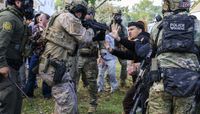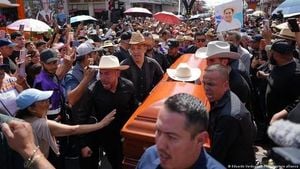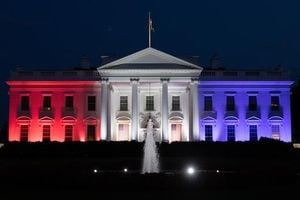On Tuesday, October 14, 2025, the normally quiet intersection of 105th Street and Avenue N on Chicago’s Far South Side erupted into chaos after a federal immigration enforcement operation spiraled out of control, leaving a community shaken and city officials demanding answers. What began as a high-speed chase by federal agents ended with a controversial crash, a cloud of tear gas, and accusations that the Department of Homeland Security (DHS) violated both civil rights and a federal court order.
According to reports from WLS, Sun-Times, and NBC 5 Investigates, Border Patrol agents pursued a red SUV through a residential neighborhood, ultimately deploying a precision immobilization technique—a maneuver that is banned or heavily restricted by many police departments due to its inherent risks. Security footage captured the federal vehicle ramming the red SUV, sending its occupants tumbling out as the car skidded to a halt. The driver, later identified as Luis Gerardo Pirela-Ramirez, and passenger Yonder Enrique Tenefe-Perez, were arrested on allegations of living in the U.S. without legal permission. DHS claimed the driver had rammed their vehicle first, justifying their aggressive response.
The commotion quickly drew a crowd of onlookers and protesters, many of whom were already wary of increased federal immigration enforcement in their neighborhood. As the crowd swelled, federal agents responded with force—deploying smoke grenades, pepper balls, and at least three rounds of tear gas. Children, seniors, and even Chicago police officers were caught in the chemical haze. Thirteen CPD officers, who were on scene to document the crash and help de-escalate tensions, were themselves overcome by tear gas, according to statements from the Chicago Police Department.
“The eyes and the nose ... it burned,” recalled community member Pascal Manuel to NBC 5 Investigates, describing the sudden and painful effects of the gas. In a video posted to social media, parents could be seen running from the area, clutching babies and shielding their faces. “When you’re using these tactics, you are asking people to be hospitalized,” Oscar Sanchez, a member of a rapid response network, told the Sun-Times. He recounted seeing an agent strike a teenage girl in the head with a tear gas canister and elderly residents sprawled on the ground. “Why is the aggression needed? Why are these elevated tactics even being used?” Sanchez asked.
Among those detained was a 15-year-old boy, a U.S. citizen, who was slammed to the ground and handcuffed by masked federal agents. His cousin, Destiny Salazar, described the harrowing scene: “They threw him to the ground and as [he] was saying, ‘My neck, my neck,’ [the federal agent] just kept pushing him down more and more.” The boy’s mother, Juanita Garnica, rushed to the scene in tears, desperate for information about her son’s whereabouts. Attorneys from Romanucci and Blandin, the firm representing the boy’s family, later revealed that he was held in a garage for five hours—without being allowed to contact his family or legal counsel, and without being informed of any charges. “This is not law enforcement; this is the playbook of authoritarian regimes,” attorney Antonio Romanucci declared in a statement, likening the tactics to a dark period in American history. The boy was eventually released without charges, but the trauma lingered.
The incident quickly drew condemnation from community leaders, politicians, and civil rights advocates. Ana Guajardo of United Workers’ Center stated, “We do not welcome ICE in the Southeast Side of Chicago, the south suburbs of Chicago, the entire city of Chicago, as we will continue to organize and advocate for those who are affected, as we see not only, but also people of color are being racially profiled by unjust actions.” Moises Moreno of 10th Ward Rapid Response added, “The Trump administration continues to lie and claims only to be targeting criminals. But we have seen hardworking people, landscapers, construction workers and street vendors specifically targeted.”
Illinois Governor JB Pritzker also weighed in, sharply criticizing the federal agents’ actions and suggesting they may have violated a temporary restraining order (TRO) issued just the previous week. The TRO, handed down by Judge Sara Ellis, explicitly banned the use of riot control munitions—including tear gas and pepper bullets—by DHS agents at demonstrations. “They’re the ones who are tossing tear gas when people are peacefully protesting. ICE is the one who’s going into neighborhoods where they, frankly, are causing fear among people who live in those neighborhoods, work in those neighborhoods,” Pritzker told reporters. He hinted at possible legal repercussions, noting that attorneys might return to court to ensure the order is enforced.
DHS, for its part, defended the use of tear gas, claiming the crowd had turned hostile and that their agents were facing a surge in assaults. In a statement, a spokesperson asserted, “This incident is not isolated and reflects a growing and dangerous trend of illegal aliens violently resisting arrest and agitators and criminals ramming cars into our law enforcement officers.” The agency further alleged that the 15-year-old boy had thrown eggs at officers and was arrested for assault, but was released without charges after admitting to his actions.
Yet, many residents saw things differently. Some described feeling like they were under siege, with one resident telling WLS, “He saw a man with a big rifle right in front of his house. He immediately went back inside because he said, ‘What are we under attack? Is this a war? What’s happening?’” Others, like Maricela Estrada of United Workers’ Center, canvassed the neighborhood to reassure residents of their rights and urge them to stay calm in the face of federal operations. “It feels like they’re just, really going after anybody that looks brown, or just interferes, you know. It just feels like they’re just really after us,” another resident confided.
The fallout has extended beyond Tuesday’s events. Cook County has recently banned ICE from enforcing civil warrants at courthouses, a move now being considered for statewide expansion. State Representative Emanuel "Chris" Welch argued, “People are afraid to go to court. They’re afraid to comply with subpoenas. We can’t allow that.” Meanwhile, DHS has informed Naval Station Great Lakes that it will extend its use of the base for immigration enforcement through the end of the year, raising concerns among local leaders about the ongoing federal presence.
State Senator Elgie Sims called the use of chemical agents in his district “unjust” and urged unity: “No person should be targeted by the color of their skin, and no group should be attacked for standing up for what is right.” Chicago’s deputy mayor of immigration and refugee rights, Beatriz Ponce De Leon, put it bluntly: “This type of escalation is going to cause harm—it’s not the people of Chicago. It is the federal agents.”
As the dust settles, Chicago’s Southeast Side is left to grapple with the aftermath of a federal operation that upended lives and reignited a fierce debate over immigration enforcement, civil liberties, and the proper boundaries of federal power in American cities.






